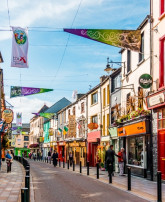
How to Play Golf, a Complete Beginner’s Guide
Posted: 31 May 2019

What Are the Basic Rules of Golf?
The R&A (The Royal and Ancient Golf Club of St Andrews) and the USGA (United States Golf Association) govern the sport of golf worldwide.They operate in separate jurisdictions, but share a commitment to a single code for the rules of golf. While the rules are varied and many, for the complete beginner, the best place to start is to review the R&As Quick Guide to the Rules.Getting Started
• General Points
• The Tee Shot
• Playing the Ball
• On the Putting Green
• Ball at Rest Moved
• Ball in Motion, Deflected, or Stopped
• Ball Assisting or Interfering With Play
• Loose Impediments
• Movable Obstructions
• Immovable Obstructions and Abnormal Ground Conditions
• Water Hazards
Lost, Provisional and Unplayable Balls
• Ball Lost or Out of Bounds, Provisional Balls
• Ball Unplayable
What is the Golf Handicap System?

Golfers of many years’ experience will most likely record far better scores than those who are new to the game, so by using the handicapping system, the novice player is given a better chance of competing on a level playing field with accomplished veterans of the sport.
How to Swing a Golf Club
Step 1: Push Back and Angle Down
• Push your hips back.
• Angle your spine towards the ball to set good posture.
• Flex your knees slightly for stability.
• Ensure that your right side is lower than your left.
• The ball should be in line with the left side of your face.
• The clubface should be facing the target.
Step 2: Position the Club First
• As the hands pass your right leg, shift your weight to the right.
• When the club reaches parallel to the ground, it should be parallel to the target line too so that it is swinging on the correct arc.
• The clubface at that point should be toe up and square to the swing arc.
Step 3: Move Your Weight to the Right Side
• This is so your right arm does not dominate the swing.
• Once your shoulders begin to rotate, pull your hips into the swing and feel a loading action in your right hip.
Step 4: Stretch Your Left Lat
• Your hips should be turned half as far as the shoulders.
• Your left arm should remain straight but not rigid.
• Your right elbow should point to the ground.
• The hands should swing back to 11 o'clock.
• Your hands and arms must be under the club to support its weight when holding it over your head.
Step 5: Lead With Your Lower Body
• Start dropping your arms.
• Return your right elbow to a position in front of your right hip.
• Your belt buckle should point at the ball.
• Your shoulders should still be closed to the target.
• Work the lower body and keep your head behind the ball.
Step 6: Straighten Your Left Side Upon Impact
• Straighten your left side as your right side moves forward.
• Keep your hands slightly in front of the clubhead at impact.
• Keep your left wrist flat and your right wrist bent.
Step 7: Extend and Rotate on the Follow-Through
• On the follow through, extend both of your arms fully.
• Keep your right shoulder down, not turning in conjunction with the left.
• Swing your arms back to the inside.
• Kick your right knee inward and keep your left leg straight.
• Keep the clubhead below your hands.
Step 8: Keep Your Right Side Moving to Finish
• Your momentum should take your arms behind your head.
• Your right foot should be on its toes, with your body weight on your left heel.
• Your shoulders should have turned more than your hips so as to achieve a full upper body release.
• If you have done it exactly right, your body is comfortably balanced as it was immediately before starting the swing.
Perfecting the Correct Golf Grip
This step by step 10 minute video from Free Online Golf Tips explains how the correct golf grip should look and feel.The Interlinking Grip:
• Your two little fingers are interlinking with one another as you grip the club.
• The little finger on your right hand rests partially on top of the little finger on your left hand as you grip the club.
The Baseball Grip:
• Your two little fingers are directly alongside one another, but not linking or overlapping in any way, as you grip the club.
Gripping With Your Left Hand:
2. Grip the golf club half an inch from the end. This will give you the best balance of golf club control, ball-striking ability and necessary power.
3. When you look down at your left hand, you should be able to see two and a half knuckles. The ‘V’ shape made by your left thumb and forefinger should point towards your right shoulder.
2. The ‘V’ shape made between your right thumb and forefinger should point towards your chin.
3. If the ‘V’ shape points over your left shoulder, your right hand is in too weak a position.
There is a school of thought that believes that gripping your golf club tightly causes tension in your body and negatively affects your swing. On the contrary, having a firm grip of the club at the point of impact with the ball gives you better control of the strike.
When you go to begin your swing, your grip should be a happy medium between tight and loose. Then, as you come down to strike the ball, the grip should be as tight as possible. Try to take note of how tightly you grip the golf club at the point of impact with the ball to see the effect it has on your strike.
Getting Your Golf Stance Right

• For all full shots, the insides of your feet should be half a golf club width apart.
• Widen your stance by two to three inches when using longer clubs e.g. the driver.
• Narrow your stance by one to two inches when using shorter clubs e.g. short irons and wedges.
• Do not point your toes out at a wide angle.
• Your back foot should be at a right angle to the target line.
• Your front foot should only be very slightly angled outwards.
• Do not bend your knees fully; they should only be lightly flexed.
• For most shots, spread your body weight evenly between your toes and heels, and also between your feet.
Golf Chipping Tips for Beginners

• To get closer to the ball, move your hands towards the bottom of the grip (closer to the bare shaft of the golf club).
• This is often referred to as ‘choking down’ by golfers.
Top Tip 2
• Flex your knees slightly more than usual.
• Do not hunch over the ball.
• Take a narrow stance.
• Keep your body open so that it can easily rotate as you take the chip shot.
Top Tip 4
• Do not let your body become too square.
• If you do, it will resist rotating, your hands will begin to flip, which will cause you to lose control over your shot.
Top Tip 5
• Keep most of your body weight on its forward side with the ball back in your stance.
• This is so you can achieve consistent contact with the ball and more control over your shot.
Top Tip 6
• Keep your head up and your neck in line with your spine.
• Be sure that your eyes are firmly on your ball.
Top Tip 7
• Use a variety of clubs for chipping, depending on the situation.
• An 8-iron is ideal for low-rolling chips. A pitching wedge works better in deeper grass. A sand wedge is made for chip shots in bunkers.
The Importance of Golf Etiquette

Etiquette is an integral part of the game of golf. It defines the game’s core values and describes the manner in which the game of golf should be played. This is to ensure that all players gain maximum enjoyment.
• Always leave the course as you would like to find it.
• Repair pitch-marks, replace divots and rake bunkers.
Fellow Players
• Always be sportsmanlike and polite.
• Avoid distracting other players.
• Keep up the pace when in a group.
• Learn the rules and how to apply them to the game.
























































